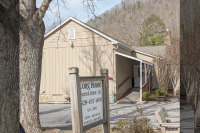House hunting for elk: Conservation project seeks to attract elk, tourism
 Things have gone well for the Smokies elk, and they’ve risen from reintroduction experiment to established population. But meanwhile, they’ve outgrown Great Smoky Mountains National Park, spilling over into private lands to find pasture on agricultural fields not intended as gifts to the elk. A land protection project by The Conservation Fund seeks to provide some more suitable places for the elk to go.
Things have gone well for the Smokies elk, and they’ve risen from reintroduction experiment to established population. But meanwhile, they’ve outgrown Great Smoky Mountains National Park, spilling over into private lands to find pasture on agricultural fields not intended as gifts to the elk. A land protection project by The Conservation Fund seeks to provide some more suitable places for the elk to go.
“The reason the elk have come out of the park is there are now more elk than there is habitat to sustain them, so the [N.C.] Wildlife [Resources] Commission is going to need to work to create some habitat that both elk and people will enjoy,” said Bill Holman, state director of The Conservation Fund.
In September, The Conservation Fund saw its first major victory in pursuit of that goal when it bought the 561-acre Sheepback Mountain Property, north of Maggie Valley and adjacent to the national park, for about $1.7 million. One million of that came from the N.C. Clean Water Management Trust Fund, a significant amount considering that this year the fund doled out $12.7 million to 38 projects statewide.
But the final tract will probably be a good bit more than 561 acres, likely closer to 2,000. Though no contracts have yet been signed, negotiations are wrapping up for The Conservation Fund’s purchase of three properties owned by Sammy Carver, Robert Williams, Sr. and Thornton Hawkins. The three properties touch each other but not the Sheepback Mountain property. However, all four are tied together by their borders with Great Smoky Mountains National Park.
“All three property owners are willing to sell it for public benefit for less than fair market value, and we very much appreciate their generosity,” Holman said, adding that all three have in the past been approached by developers and refused to sell.
Related Items
A home for elk
If the sale went through, The Conservation Fund would then deed the land to the Wildlife Commission to manage. The goal of that management would be to create more of the meadow-like habitat that many animals, such as warblers, turkey, ruffed grouse — and, of course, elk — need to thrive. Management would likely include logging and controlled burns.
“It was pasture land, open land, which as since most of it has since grown up — some of it quite a bit — there would have to be some habitat manipulation to create some grassy open area and young forest areas to benefit elk and other critters,” said Dave Stewart, land management biologist for the Wildlife Commission.
The land, managed to draw elk and other meadow-loving creatures, could even someday become an elk game land. If, that is, the deal goes through, and if elk populations continue to grow, and if they are eventually designated a game species with a season.
A lot of ifs.
“That would really depend on our population and doing some modeling and figuring how many elk we could pull off the landscape and still have a sustainable herd,” said Justin McVey, wildlife biologist for the Wildlife Commission.
“If populations get to be to the numbers that we’d like, we’d like to have a huntable population,” Stewart said. “Time will tell.”
The draw of having 2,000 acres full of elk, though, wouldn’t be limited to the possibility of some future opportunity for hunters wanting to mount a six-pointer over their fireplace. It would have plenty of benefit in the here and now.
“I love going to Cataloochee, a lot of people love going to Cataloochee, but it’s not the easiest place to get to,” Holman said, “so I think creating some watchable wildlife opportunities that are more convenient to the public will only increase the number of people who come to Haywood County to see the elk and to enjoy all the other great natural resources in the county.”
Getting to Cataloochee, the area of the park with the biggest elk population, involves a harrowing drive up a winding, one-lane route with steep grades, steeper drop-offs and miles of unpaved road. Even for those used to mountain driving, it’s not an easy trip. But nevertheless, visitation to the Cataloochee area of the park has doubled since the elk were reintroduced.
The idea is that the more attractions there are to lure outdoorsy tourists to Haywood County, the more often they’ll come and the longer they’ll stay.
The case for conservation
That’s the impetus behind another project The Conservation Fund has going in Haywood County, which involves about 5,000 acres of land near Waterrock Knob on the Haywood-Jackson county line. That land is a conglomeration of easements from The Conservation Fund, The Nature Conservancy, The Conservation Trust for North Carolina and the Southern Appalachian Highlands Conservancy.
The goal? To bundle all those acres together and convey them to the National Park Service to serve as an addition to the Waterrock Knob area, located at milepost 451. Right now, the area features a visitor’s center and a 0.6-mile trail up to the knob. It’s a popular place, but Holman thinks it has potential to be even more so.
“It’s close to 5,000 acres that could be added to the Blue Ridge Parkway and Waterrock Knob and create a lot more opportunities for more trail and more things for people to do when they come to Waterrock Knob,” he said.
For instance, what if there was a trail leading from Waterrock Knob to Browning Knob, through the Plott Balsams and down into Maggie Valley and Waynesville?
“It would be a spectacular high-elevation trail that would drive more recreation opportunities for the public but also provide a reason for people to extend their stay when they come to Haywood County,” Holman told a receptive Haywood Tourism Development Authority last week.
“One of the questions was, ‘Would you stay longer if there was more to do?’ and the answer was yes, they would stay up to two days longer,” commented TDA Executive Director Lynn Collins, referencing a presentation on the topic that Conservation Fund Stanback intern Erika Zambello made this summer.
Zambello’s project sought to find the economic case for land conservation, drawing largely from a survey of visitors to Waterrock Knob. On average, she said, visitors spent about $68 per person, per day, with the average group staying for 3.39 days. Of the 157 people surveyed, 51 percent said they were staying at a hotel or motel, while 49 percent said they made $75,000 or more, meaning that people who come to sites such as Waterrock Knob have money to spend and will do so as long as they’re visiting the area.
Holman hopes to have the Waterrock Knob project wrapped up — the property consolidated, the land deeded to the Park Service — sometime in 2015.
“We think it’s a great project,” said Leesa Brandon, public information officer for the Parkway.
Two projects, similar goals
The Waterrock Knob and Wildlife Commission parcels are part of two distinct projects, but they’re connected by the Parkway corridor and by the common benefits they’ll provide to Haywood County in terms of tourism and environmental benefits.
“They’re all complimentary,” Holman said. “All of these projects have the benefits of they help protect Maggie Valley’s drinking water, they protect the integrity of the Blue Ridge Parkway and Great Smoky Mountains National Park, and they provide great recreational opportunities for the public.”
What they also have in common is that they’re not cheap. Even with the landowners selling for something below fair market value, the 2,000 acres near Sheepback Mountain will likely cost The Conservation Fund somewhere in the neighborhood of $5.3 million, Holman said, though the exact figure could vary.
“When we buy property, we have to borrow money to do it, so the sooner we can convey the property to the Wildlife Commission, the less interest carry costs there are,” Holman explained.
But by turning the property over to be managed for wildlife and ecology, Holman said, landowners are allowing permanent protection for Maggie Valley’s drinking water as well as a bedrock of potential for future recreation and tourism in Haywood County.
“We have been impressed by the conservation ethic of these landowners,” Holman said.
To help The Conservation Fund foot the bill for this project, mail checks to The Conservation Fund at P.O. Box 271, Chapel Hill, N.C. 27514.
An example to follow
Better views translate to better visitation and enjoyment of the Blue Ridge Parkway, said Parkway public information officer Leesa Brandon, and that’s a lesson that the Haywood Tourism Development Authority seems to know well.
She called the board’s interest in Parkway conservation and commitment to keeping views open — in the years when the Park Service doesn’t have funds to clear overgrown overlooks in the area, the TDA pays to have it done in Haywood County, about $20,000 last year — “a wonderful indicator of success.” Other Parkway communities are taking note.
“We did a project just earlier this month up in Roanoke [Virginia] trying to do some vista work, and they really learned a lot from Haywood County about how that project works and how to replicate it more and more on the Virginia side of the park,” Brandon said.
Groups in Virginia had previously done a good bit of work with planting trees to screen unsightly views but hadn’t really done much to clear overgrown pull-offs to open up high-quality views.
“That’s a model, really, for the rest of the park,” Brandon said.









